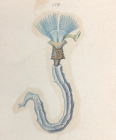WoRMS name details
Placostegus caeruleus Schmarda, 1861
338033 (urn:lsid:marinespecies.org:taxname:338033)
uncertain > taxon inquirendum (indeterminable as subjective synonym of two other taxa)
Species
marine, brackish, fresh, terrestrial
recent only
Schmarda, L. K. (1861). Neue Wirbellose Thiere: Beobachted und Gesammelt auf einer Reise um die Erdr 1853 bis 1857. <em>In Turbellarien, Rotatorien und Anneliden. Leipzig, Verlag von Wilhelm Engelmann.</em> Erster Band, Zweite Hälfte., available online at http://www.biodiversitylibrary.org/ia/neuewirbelloseth21861schm
page(s): 29, Plate 21, figure 178; note: from South Africa and from New Zealand [details]
page(s): 29, Plate 21, figure 178; note: from South Africa and from New Zealand [details]
Note "Vorgebirge der guten Hoffnung und...
From editor or global species database
Type locality "Vorgebirge der guten Hoffnung und Neu-Seeland, auf Felsen" . [Promontory of Good Hope and New Zealand, on rocks] [details]
Etymology Not stated, but 'caeruleus' is Latin for sky blue. In reality the radiolar fan of Pomatoceros caeruleus is a darker blue...
Status Current knowledge is that Schmarda (1861) combined different but related intertidal species from two places in his...
Taxonomy Moved to different genera
Etymology Not stated, but 'caeruleus' is Latin for sky blue. In reality the radiolar fan of Pomatoceros caeruleus is a darker blue than sky blue [details]
Status Current knowledge is that Schmarda (1861) combined different but related intertidal species from two places in his...
Status Current knowledge is that Schmarda (1861) combined different but related intertidal species from two places in his description of Placostegus caeruleus, namely Cape of Good Hope, South Africa and New Zealand. The type material is believed lost (Glasby & Read, 1998). The Cape of Good Hope material was what is now Spirobranchus kraussii (Baird, 1865), and the New Zealand material was what is now Spirobranchus cariniferus (Gray, 1843). Schmarda's colour plate of tube and worm is probably more like the South African species than the New Zealand species, but his name cannot be assigned as a synonym to just one of them as he didn't indicate which he based the description on, presumably finding the specimens indistinguishable. His name is junior to both taxa, so there is currently no nomenclature issue arising from the uncertainty of identification. [details]
Taxonomy Moved to different genera
Taxonomy Moved to different genera [details]
Read, G.; Fauchald, K. (Ed.) (2024). World Polychaeta Database. Placostegus caeruleus Schmarda, 1861. Accessed through: World Register of Marine Species at: https://www.marinespecies.org/aphia.php?p=taxdetails&id=338033 on 2024-04-19
Date
action
by
![]() The webpage text is licensed under a Creative Commons Attribution 4.0 License
The webpage text is licensed under a Creative Commons Attribution 4.0 License
original description
Schmarda, L. K. (1861). Neue Wirbellose Thiere: Beobachted und Gesammelt auf einer Reise um die Erdr 1853 bis 1857. <em>In Turbellarien, Rotatorien und Anneliden. Leipzig, Verlag von Wilhelm Engelmann.</em> Erster Band, Zweite Hälfte., available online at http://www.biodiversitylibrary.org/ia/neuewirbelloseth21861schm
page(s): 29, Plate 21, figure 178; note: from South Africa and from New Zealand [details]
taxonomy source Simon, Carol A; van Niekerk, H. Helene; Burghardt, Ingo; ten Hove, Harry A.; Kupriyanova, Elena K. (2019). Not out of Africa: Spirobranchus kraussii (Baird, 1865) is not a global fouling and invasive serpulid of Indo-Pacific origin. <em>Aquatic Invasions.</em> 14(2): 221-249., available online at http://www.aquaticinvasions.net/2019/issue2.html
note: includes comments on Schmarda's name [details] Available for editors [request]
[request]
source of synonymy Hartman, Olga. (1959). Catalogue of the Polychaetous Annelids of the World. Parts 1 and 2. <em>Allan Hancock Foundation Occasional Paper.</em> 23: 1-628. [details] Available for editors [request]
[request]
source of synonymy Zibrowius, H. (1973). Serpulidae (Annelida Polychaeta) des côtes ouest de l'Afrique et des Archipels Voisins. <em>Annales du Musée Royal de l'Afrique Centrale, Tervuren, Belgique. Sciences Zoologiques.</em> (series 8) 207: 1-93.
page(s): 72 [details] Available for editors [request]
[request]
page(s): 29, Plate 21, figure 178; note: from South Africa and from New Zealand [details]
taxonomy source Simon, Carol A; van Niekerk, H. Helene; Burghardt, Ingo; ten Hove, Harry A.; Kupriyanova, Elena K. (2019). Not out of Africa: Spirobranchus kraussii (Baird, 1865) is not a global fouling and invasive serpulid of Indo-Pacific origin. <em>Aquatic Invasions.</em> 14(2): 221-249., available online at http://www.aquaticinvasions.net/2019/issue2.html
note: includes comments on Schmarda's name [details] Available for editors
source of synonymy Hartman, Olga. (1959). Catalogue of the Polychaetous Annelids of the World. Parts 1 and 2. <em>Allan Hancock Foundation Occasional Paper.</em> 23: 1-628. [details] Available for editors
source of synonymy Zibrowius, H. (1973). Serpulidae (Annelida Polychaeta) des côtes ouest de l'Afrique et des Archipels Voisins. <em>Annales du Musée Royal de l'Afrique Centrale, Tervuren, Belgique. Sciences Zoologiques.</em> (series 8) 207: 1-93.
page(s): 72 [details] Available for editors
From editor or global species database
Editor's comment Schmarda's material from Cape of Good Hope belongs to Pomatoleios kraussii (fide Zibrowius 1973); however that from New Zealand should be attributed to Spirobranchus cariniferus (fide Glasby & Read 1998) [details]Etymology Not stated, but 'caeruleus' is Latin for sky blue. In reality the radiolar fan of Pomatoceros caeruleus is a darker blue than sky blue [details]
Status Current knowledge is that Schmarda (1861) combined different but related intertidal species from two places in his description of Placostegus caeruleus, namely Cape of Good Hope, South Africa and New Zealand. The type material is believed lost (Glasby & Read, 1998). The Cape of Good Hope material was what is now Spirobranchus kraussii (Baird, 1865), and the New Zealand material was what is now Spirobranchus cariniferus (Gray, 1843). Schmarda's colour plate of tube and worm is probably more like the South African species than the New Zealand species, but his name cannot be assigned as a synonym to just one of them as he didn't indicate which he based the description on, presumably finding the specimens indistinguishable. His name is junior to both taxa, so there is currently no nomenclature issue arising from the uncertainty of identification. [details]
Taxonomy Moved to different genera [details]
Type locality "Vorgebirge der guten Hoffnung und Neu-Seeland, auf Felsen" . [Promontory of Good Hope and New Zealand, on rocks] [details]
